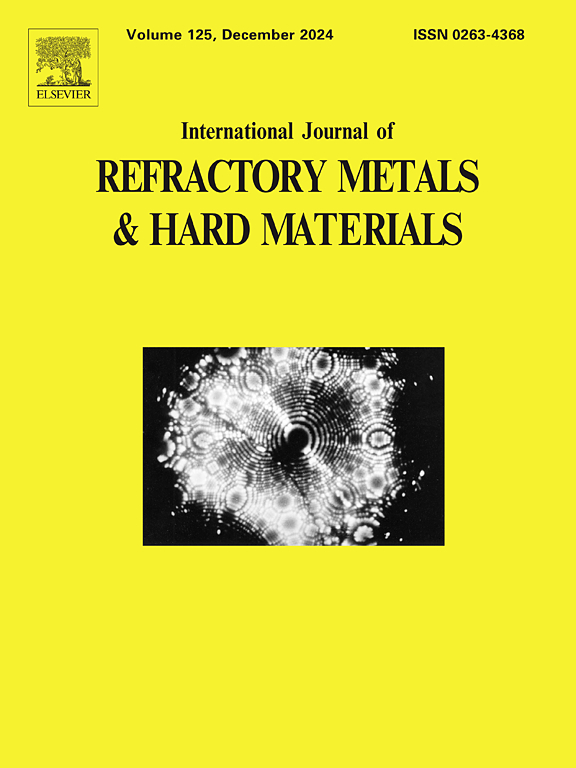Dynamic strain aging and serrated flow behaviour of Ta-2.5 W alloy
IF 4.2
2区 材料科学
Q2 MATERIALS SCIENCE, MULTIDISCIPLINARY
International Journal of Refractory Metals & Hard Materials
Pub Date : 2025-02-26
DOI:10.1016/j.ijrmhm.2025.107121
引用次数: 0
Abstract
The compression behaviour of the Ta-2.5 W alloy was investigated over the temperature range from room temperature to 450 °C at strain rates of 0.001 s−1, 0.01 s−1, 0.1 s−1, 1 s−1, 5 s−1, and 10 s−1. The test results are thoroughly analysed with particular attention to the typical features and mechanism of dynamic strain aging (DSA) and its effects on microstructure evolution. The stress-strain curves clearly exhibit the serrated flow behaviour, and a continuous variation in serration style from A to A + B or A + CA with increasing deformation temperature occurred. The typical characteristics of serrated yielding, positive temperature sensitivity in flow stress, increased work hardening rate and negative strain rate sensitivity indicate the occurrence of DSA. With increasing accumulated strain, the negative strain rate sensitive region moves to high temperatures and contracts at low strain rates, whereas it expands at higher strain rates. The alloy exhibited both normal and inverse Portevin-Le Chatelier effects, which originate from the interaction between interstitial or substitutional solute atoms and moving dislocations, resulting in the appearance of planar slip, dislocation loops and dislocation walls. Higher strain rates and DSA inhibit dynamic recovery and result in higher dislocation densities and low angle grain boundary frequency.
Ta-2.5 W合金的动态应变时效及锯齿状流动行为
在室温至450℃的温度范围内,研究了Ta-2.5 W合金在应变速率为0.001 s−1、0.01 s−1、0.1 s−1、1 s−1、5 s−1和10 s−1下的压缩行为。对试验结果进行了深入分析,重点分析了动态应变时效的典型特征、机理及其对微观组织演变的影响。应力应变曲线表现出明显的锯齿状流动特征,且随着变形温度的升高,从a到a + B或a + CA的锯齿状流动类型呈连续变化。锯齿形屈服、流动应力正温度敏感性、加工硬化速率增大和应变速率负灵敏度的典型特征表明DSA的发生。随着累积应变的增加,负应变率敏感区向高温移动,在低应变率下收缩,而在高应变率下膨胀。该合金表现出正态和逆态的Portevin-Le Chatelier效应,这是由于间隙或取代溶质原子与移动位错之间的相互作用,导致了平面滑移、位错环和位错壁的出现。较高的应变率和DSA抑制了动态恢复,导致更高的位错密度和低角晶界频率。
本文章由计算机程序翻译,如有差异,请以英文原文为准。
求助全文
约1分钟内获得全文
求助全文
来源期刊
CiteScore
7.00
自引率
13.90%
发文量
236
审稿时长
35 days
期刊介绍:
The International Journal of Refractory Metals and Hard Materials (IJRMHM) publishes original research articles concerned with all aspects of refractory metals and hard materials. Refractory metals are defined as metals with melting points higher than 1800 °C. These are tungsten, molybdenum, chromium, tantalum, niobium, hafnium, and rhenium, as well as many compounds and alloys based thereupon. Hard materials that are included in the scope of this journal are defined as materials with hardness values higher than 1000 kg/mm2, primarily intended for applications as manufacturing tools or wear resistant components in mechanical systems. Thus they encompass carbides, nitrides and borides of metals, and related compounds. A special focus of this journal is put on the family of hardmetals, which is also known as cemented tungsten carbide, and cermets which are based on titanium carbide and carbonitrides with or without a metal binder. Ceramics and superhard materials including diamond and cubic boron nitride may also be accepted provided the subject material is presented as hard materials as defined above.

 求助内容:
求助内容: 应助结果提醒方式:
应助结果提醒方式:


